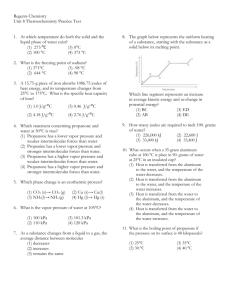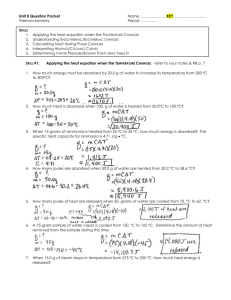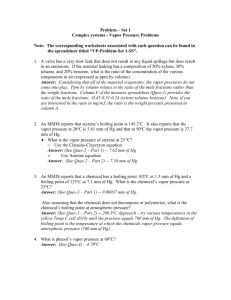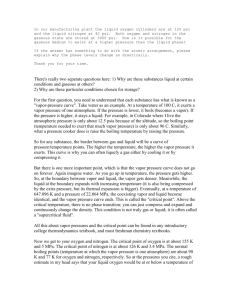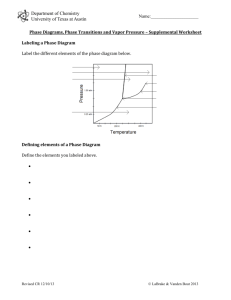Practice Qs - Unit 8
advertisement
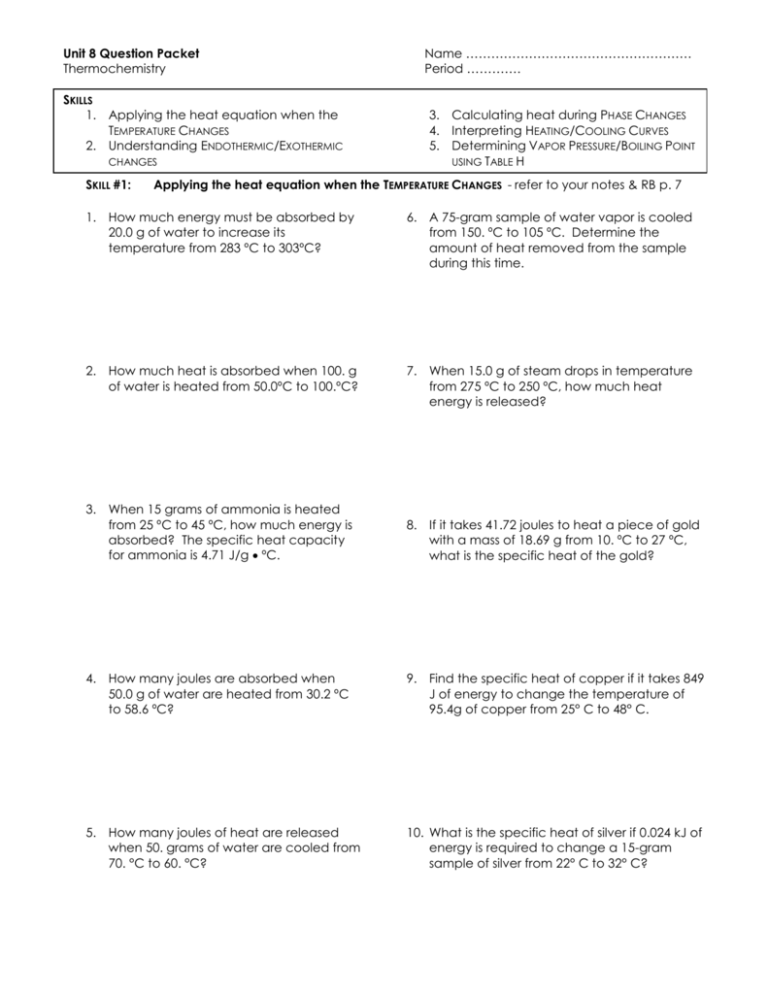
Unit 8 Question Packet Thermochemistry SKILLS 1. Applying the heat equation when the TEMPERATURE CHANGES 2. Understanding ENDOTHERMIC/EXOTHERMIC CHANGES SKILL #1: Name ……………………………………………… Period …………. 3. Calculating heat during PHASE CHANGES 4. Interpreting HEATING/COOLING CURVES 5. Determining VAPOR PRESSURE/BOILING POINT USING TABLE H Applying the heat equation when the TEMPERATURE CHANGES - refer to your notes & RB p. 7 1. How much energy must be absorbed by 20.0 g of water to increase its temperature from 283 ºC to 303ºC? 6. A 75-gram sample of water vapor is cooled from 150. ºC to 105 ºC. Determine the amount of heat removed from the sample during this time. 2. How much heat is absorbed when 100. g of water is heated from 50.0ºC to 100.ºC? 7. When 15.0 g of steam drops in temperature from 275 ºC to 250 ºC, how much heat energy is released? 3. When 15 grams of ammonia is heated from 25 ºC to 45 ºC, how much energy is absorbed? The specific heat capacity for ammonia is 4.71 J/g ºC. 8. If it takes 41.72 joules to heat a piece of gold with a mass of 18.69 g from 10. ºC to 27 ºC, what is the specific heat of the gold? 4. How many joules are absorbed when 50.0 g of water are heated from 30.2 ºC to 58.6 ºC? 9. Find the specific heat of copper if it takes 849 J of energy to change the temperature of 95.4g of copper from 25° C to 48° C. 5. How many joules of heat are released when 50. grams of water are cooled from 70. °C to 60. °C? 10. What is the specific heat of silver if 0.024 kJ of energy is required to change a 15-gram sample of silver from 22° C to 32° C? 11. A certain mass of water was heated with 41,840 J, raising its temperature from 22 ºC to 28.5 ºC. Find the mass of the water. 16. If 20. grams of water vapor is cooled by removing 45 J of heat, what is its temperature change? 12. The temperature of a sample of water changes from 10. °C to 20. °C when the water absorbs 420 joules of heat. What is the mass of the sample? 17. A 36-gram sample of water has an initial temperature of 22°C. What is the final temperature of the sample after it absorbs1200 joules of heat energy? 13. A sample of water is heated from 35° C to 45° C with 1,600 joules. What is the mass of the sample? 18. A 15-gram sample of water has an initial temperature of 25°C. What is the final temperature of the sample after it loses 125 joules of heat energy? 14. If 720.0 g of steam at 400. ºC absorbs 800. kJ of heat energy, what will be its increase in temperature? 19. An 18-gram sample of water has a temperature of 16°C after it has absorbed 527 joules of heat energy. What was the initial temperature of the sample? 15. What would be the temperature change if 15 g of water absorbed 75 J of heat? 20. A 115-gram sample of water has a temperature of 60.°C after it has absorbed 1,923 joules of heat energy. What was the initial temperature of the sample? 21. A student performed an experiment to determine the total amount of energy stored in a peanut. The accepted value for the energy content of a peanut is 30.2 kilojoules per gram. The student measured 100.0 grams of water into a metal can and placed the can on a ring stand, as shown in the diagram below. The peanut was attached to a wire suspended under the can. The initial temperature of the water was recorded as 22.0°C. The peanut was ignited and allowed to burn. When the peanut finished burning, the final water temperature was recorded as 57.0°C. The student’s experimental value for the energy content of this peanut was 25.9 kilojoules per gram. (a) Calculate the total amount of heat absorbed by the water. Your response must include both a correct numerical setup and the calculated result. (b) Determine the student’s percent error for the energy content of this peanut. SKILL #2: understanding ENDOTHERMIC/EXOTHERMIC CHANGES - refer to your notes & RB p. 4 22. Under each arrow, write “endothermic” or “exothermic” to indicate if the change releases or absorbs heat. Also, write in “energy” on the correct side of the arrow. a. b. Au(l) Au(s) NaCl(s) NaCl(l) c. d. NaCl(s) NaCl(l) e. C2H3O2(g) C2H3O2(l) f. C6H6(l) C6H6(g) CO2(s) CO2(g) 23. Which phase change results in the release of energy? 25. Which change is exothermic? (1) freezing of water (2) melting of iron (3) vaporization of ethanol (4) sublimation of iodine 24. Given the balanced equation representing a reaction: Cu + S CuS + energy Which statement explains why the energy term is written to the right of the arrow? (1) The compound CuS is composed of two metals. (2) The compound CuS is composed of two nonmetals. (3) Energy is absorbed as the bonds in CuS form. (4) Energy is released as the bonds in CuS form. 26. An iron bar at 325 K is placed in a sample of water. The iron bar gains energy from the water if the temperature of the water is (1) 65 K (3) 65°C (2) 45 K (4) 45°C 27. Which physical changes are endothermic? (1) melting and freezing (2) melting and evaporating (3) condensation and sublimation (4) condensation and deposition 28. Given the balanced equation: 29. Systems in nature tend to undergo changes toward (1) lower energy and lower entropy (2) lower energy and higher entropy (3) higher energy and lower entropy (4) higher energy and higher entropy SKILL #3: Calculating heat during PHASE CHANGES 32. At a pressure of 101.3 kilopascals and a temperature of 373 K, heat is removed from a sample of water vapor, causing the sample to change from the gaseous phase to the liquid phase. This phase change is represented by the equation below. H2O(g) → H2O(l) + heat Determine the total amount of heat released by 5.00 grams of water vapor during this phase change. 30. Even though the process is endothermic, snow can sublime. Which tendency in nature accounts for this phase change? (1) a tendency toward greater entropy (2) a tendency toward greater energy (3) a tendency toward less entropy (4) a tendency toward less energy 31. Which transfer of energy occurs when ice cubes are placed in water that has a temperature of 45°C? (1) Chemical energy is transferred from the ice to the water. (2) Chemical energy is transferred from the water to the ice. (3) Thermal energy is transferred from the ice to the water. (4) Thermal energy is transferred from the water to the ice. - refer to your notes & RB p. 8 34. How many kilojoules of heat must be removed to freeze 35 g of water at 0 °C? 35. How many joules are required to melt 225 g of ice at 0° C? 33. How many joules does it take to vaporize 423g of water at 100 °C? 36. In which equation does the term "heat" represent heat of fusion? (1) NaCl(s) + heat NaCl(l) (2) NaOH(aq) + HCl(aq) NaCl(aq) + H2O(l) + heat (3) H2O(l) + heat H2O(g) (4) H2O(l) + HCl(g) H3O+(aq) + Cl-(aq) + heat SKILL #4: Interpreting HEATING/COOLING CURVES - refer to your notes & RB p. 6 37. Refer to the graph below, which shows a cooling curve for a substance in a gaseous phase that was cooled during a 24-minute period. The substance gave off heat at a constant rate of 40 J/min during the entire time. The 24-minute period has been divided into five time intervals, labeled I, II, III, IV, and V. (a) What is the boiling point of the substance? _______ (b) In which interval or intervals are there two phases present? _______________________________ (c) During which interval or intervals is all of the substance a gas? _______________________ (d) During interval IV, what happens to the kinetic energy of the molecules in the substance? (e) During interval IV, what happens to the potential energy of the molecules in the substance? (f) What is the heat of vaporization for the substance? (g) What is the heat of fusion for the substance? (h) Why is the heat of vaporization always bigger than the heat of fusion? 38. A 100.0-gram sample of NaCl(s) has an initial temperature of 0°C. A chemist measures the temperature of the sample as it is heated. Heat is not added at a constant rate. The heating curve for the sample is shown below. (a) Determine the temperature range over which the entire NaCl sample is a liquid. (b) Identify one line segment on the curve where the average kinetic energy of the particles of the NaCl sample is changing. (c) Identify one line segment on the curve where the NaCl sample is in a single phase and capable of conducting electricity. 39. Base your answers to the following questions on the heating curve and cooling curve below. Heating Curve for Substance 1 Cooling Curve for Substance 2 Heating Curve 120. ºC Cooling Curve 110 ºC b. What is the freezing point of the substance? 70. ºC 50 ºC c. What is the melting point of the substance? 70. ºC 50 ºC d. At what temperature do the solid and liquid phases exist at equilibrium? e. During which segments does the kinetic energy of the substance change? 70. ºC 50 ºC 0 to 2 min 4 to 7 min 11 to 12 min (KE increases – temp. ↑) 2 to 4 min 7 to 11 min 2 to 4 min 7 to 11 min (PE increases – space btwn particles ↑) 0 to 2 min 4 to 7 min 11 to 12 min 11 to 12 min A to B C to D E to F (KE decreases – temp.) B to C D to E B to C D to E (PE decreases – space btwn particles ) A to B C to D E to F A to B 0 to 2 min E to F 4 to 7 min C to D a. What is the boiling point of the substance? f. During which segments does the kinetic energy of the substance remain the same? g. During which segments does the potential energy of the substance change? h. During which segments does the potential energy of the substance remain the same? i. During which segment does the substance exist only as a gas? j. During which segment does the substance exist only as a solid? k. During which segment does the substance exist only in the liquid phase? l. Calculate the heat of fusion for Substance 1. Heat was added at a constant rate of 35 J/min. m. Calculate the heat of vaporization for Substance 2. Heat was removed at a constant rate of 50 J/min. n. How do both the heating curve and cooling curve above illustrate that the heat of vaporization is greater than the heat of fusion? [1] 40. The graph below shows a compound being cooled at a constant rate starting in the liquid phase at 75°C and ending at 15°C. (a) What is the freezing point of the compound, in degrees Celsius? _________ (b) State what is happening to the average kinetic energy of the particles of the sample between minute 2 and minute 6. [1] (c) A different experiment was conducted with another sample of the same compound starting in the solid phase. The sample was heated at a constant rate from 15°C to 75°C. On the graph to the left, draw the resulting heating curve. 41. A hot pack contains chemicals that can be activated to produce heat. A cold pack contains chemicals that feel cold when activated. (a) Based on energy flow, state the type of chemical change that occurs in a hot pack. (b) A cold pack is placed on an injured leg. Indicate the direction of the flow of energy between the leg and the cold pack. (c) What is the Law of Conservation of Energy? Describe how the Law of Conservation of Energy applies to the chemical reaction that occurs in the hot pack. SKILL #5: Determining VAPOR PRESSURE/BOILING POINT USING TABLE H - refer to your notes & RB p.109 42. At 65°C, which compound has a vapor pressure of 58 kilopascals? (1) ethanoic acid (3) propanone (2) ethanol (4) water 44. Which liquid has the lowest vapor pressure at 65°C? (1) ethanoic acid (3) propanone (2) ethanol (4) water 43. Which liquid has the highest vapor pressure at 75°C? (1) ethanoic acid (3) propanone (2) ethanol (4) water 45. At which temperature is the vapor pressure of ethanol equal to the vapor pressure of propanone at 35°C? (1) 35°C (3) 82°C (2) 60.°C (4) 95°C 46. The boiling point of a liquid is the temperature at which the vapor pressure of the liquid is equal to the pressure on the surface of the liquid. What is the boiling point of propanone if the pressure on its surface is 48 kilopascals? (1) 25°C (3) 35°C (2) 30.°C (4) 40.°C 47. According to Reference Table H, what is the boiling point of ethanoic acid at 80 kPa? (1) 28°C (3) 111°C (2) 100°C (4) 125°C 48. Using your knowledge of chemistry and the information in Reference Table H, which statement concerning propanone and water at 50°C is true? (1) Propanone has a higher vapor pressure and stronger intermolecular forces than water. (2) Propanone has a higher vapor pressure and weaker intermolecular forces than water. (3) Propanone has a lower vapor pressure and stronger intermolecular forces than water. (4) Propanone has a lower vapor pressure and weaker intermolecular forces than water. 49. As the pressure on the surface of a liquid decreases, the temperature at which the liquid will boil (1) decreases (2) increases (3) remains the same 50. As the temperature of a liquid increases, its vapor pressure (1) decreases (2) increases (3) remains the same 51. The vapor pressure of a liquid is 0.92 atm at 60°C. The normal boiling point of the liquid could be (1) 35°C (3) 55°C (2) 45°C (4) 65°C 52. Base your answers to the questions below on the graph, which shows the vapor pressure curves for liquids A and B. (a) What is the vapor pressure of liquid A at 70°C? Your answer must include correct units. (b) At what temperature does liquid B have the same vapor pressure as liquid A at 70°C? Your answer must include correct units. (c) Which liquid will evaporate more rapidly? Explain your answer in terms of intermolecular forces.

